Want to learn some hummingbird facts for kids? The hummingbird is small but mighty. We’ll talk about why they fly so fast, where they live, what they eat, and more!

Physical Description
Hummingbirds are little birds that are only 3 to 5 inches long. Their needle-like beaks are slightly curved and less than an inch long. Their tongues are forked and almost as long as their beaks.
Hummingbirds have shimmering feathers in a rainbow of colors. Hummingbird feathers can have colors ranging from brown to blue, green, purple, red, and pink. They have very long wings for a bird that has a short body and tiny feet.
Habitat
All 330 hummingbird species can be found in the Western Hemisphere. Most hummingbirds live in Central America, South America, and the Caribbean. The United States is home to 15 different types of hummingbirds. A total of 24 hummingbird species migrate to the United States on a regular basis.
The remaining hummingbird species can be found in Central America, South America, and the Caribbean. Hummingbirds have a range of habitats that include woodlands, rainforests, deserts, and cities.
Most hummingbirds that live in the United States migrate in the winter. When the weather becomes cold, hummingbirds migrate south. Some hummingbirds travel to the warmer US states in winter. Most hummingbirds migrate to Mexico and Central America. Hummingbirds don’t migrate if they live in warmer regions.
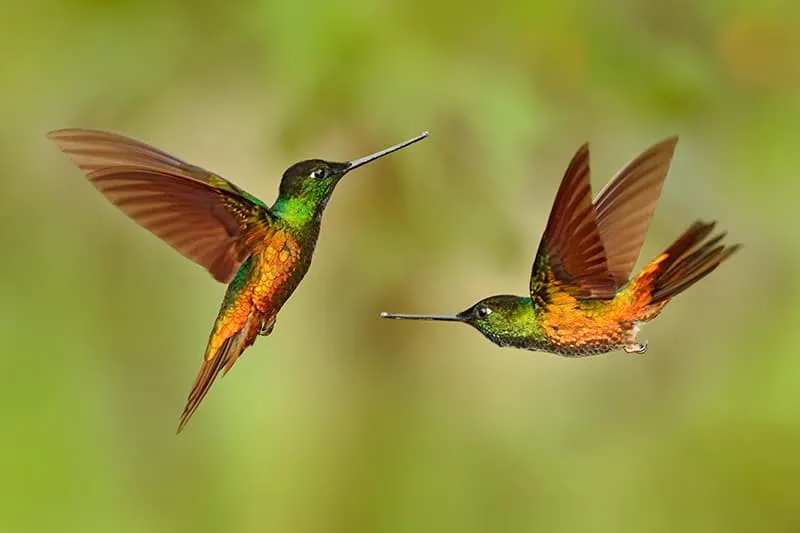
Habits
Hummingbirds are very clean. They like to bathe in birdbaths. They also collect rainwater from leaves to wash with. A hummingbird cleans and oils its feathers. It gets oil from the gland near its tail. Then it rubs the oil into its feathers. Hummingbirds will also use a small twig to clean areas they can’t reach. They clean their beaks by rubbing them against a branch.
Hummingbirds are usually active during the day and sleep at night. Hummingbirds sleep upside down. They cling to a branch from a bush or tree.
When hummingbirds go to sleep, they go into a type of hibernation. This is called torpor. Their body functions slow down. Torpor is different from hibernation because it only lasts a few hours. Hummingbirds need a long time to wake up before flying out to look for food in the morning.
Hummingbirds usually remember where all the flowers and feeders are in their territory. Hummingbirds must eat throughout the day to survive. They eat every 10-15 minutes. To keep their energy levels up, they eat half their body weight. Hummingbirds visit 1,000–2,000 flowers each day.
Hummingbirds compete for food sources. They spend a lot of time and energy chasing other hummingbirds away from flowers and feeders in their territory. Male hummingbirds have been known to divebomb bees, butterflies, larger birds, and even humans to defend their territory.
Hummingbirds make noises when protecting their territories. However, there are not very many hummingbirds in North America that sing. The few North American hummingbirds that do sing don’t sing well.
Migration
A hummingbird eats 10 times its body weight to prepare for migration. They start their migration flight with twice the amount of body weight they had before. This provides the hummingbird with the energy it needs to complete its flight.
The timing of hummingbird migration is determined by several factors. Hummingbirds do not migrate at the same time each year. The exact timing is based on the hummingbird’s location, weather, and food sources.
Every year, hummingbirds fly the same migration path alone. They fly low and stop to drink nectar from flowers. Hummingbirds will take advantage of the wind so they can save energy and fly quicker to their destination. Hummingbirds usually fly during the day. Hummingbirds will fly at night if there is no place to land.
Hummingbirds travel 23 miles a day on average. However, the distance each hummingbird travels each day varies. One hummingbird flew 48 miles a day. Another hummingbird flew 100 miles in a day. Migration routes can be hundreds or thousands of miles long.
Diet
Hummingbirds are omnivores. They feed on flower nectar but also eat insects and spiders. They are well-known for their frequent visits to hummingbird feeders. These feeders contain a sugar-water solution that is like flower nectar.
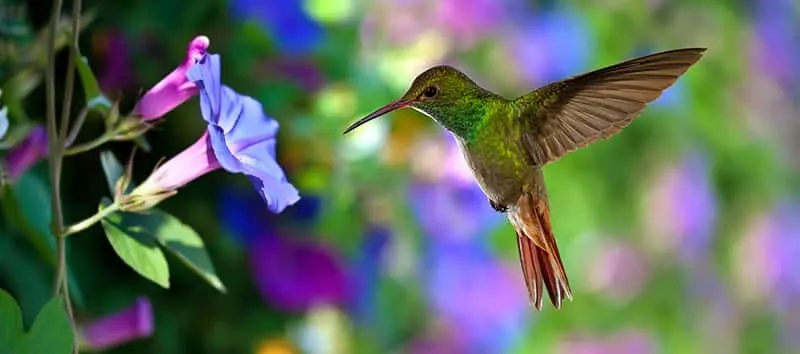
Offspring
Hummingbirds breed 1-3 times a year. Their breeding season depends on different factors. These factors are location, weather, and whether food sources are available. Hummingbirds mate when the weather is warm and dry.
Tropical hummingbirds in Central and South America breed between February and April. These are the months that it rains the least.
Hummingbirds that return from migration usually mate upon their return. Hummingbirds in North America’s temperate regions begin breeding in December.
A female hummingbird builds a nest before choosing a mate. She uses a range of items to build her nest. Litter, tiny sticks, and lichen are some of the things a hummingbird uses to build her nest with. A hummingbird’s nest is often held together by tree resin or spiderweb material.
A male hummingbird tries to show a female that he is the best of all the male hummingbirds. Male hummingbirds show off in different ways to attract females. A male hummingbird’s way of attracting a female is called a “hummingbird dance”. The male hummingbird may puff out his chest to show off his feathers. A male also shows his strength by doing some fancy aerial moves.
Hummingbird males may also do a fancy aerial dive. The male hummingbird soars as high as 150 feet before diving to the ground. He will make noises as he dives to get the female’s attention. Then, just as he’s about to strike the ground, he’ll arc back up and do it all over again.
If the female isn't interested, she flies off. If she is interested, she perches on a branch and points her bill in his direction.
After mating, the female hummingbird flies to her nest and lays eggs within 3 weeks. Hummingbirds lay two white eggs that can be as small as a tic-tac or as large as a jellybean. It takes 10-19 days for a hummingbird egg to hatch.
When hummingbird chicks hatch, they have closed eyes and no feathers. During the first month, chicks rely on their mothers for warmth, food, and protection.
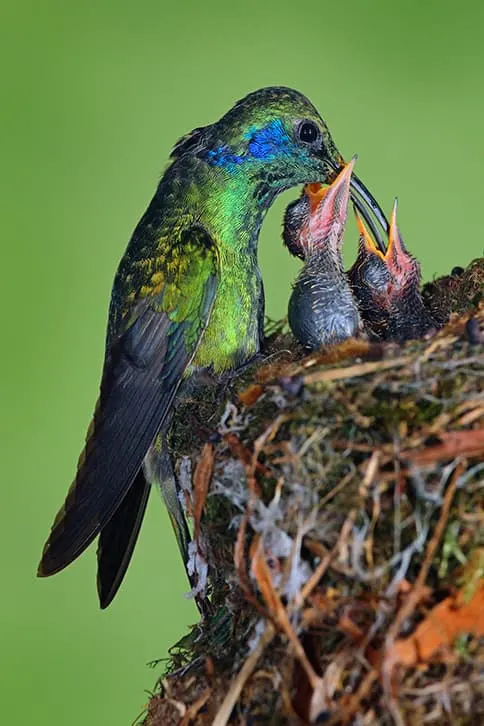
A mother hummingbird feeds her chicks insects and spiders mixed with nectar. She swallows the food then spits it back up into her chicks’ beaks.
The chicks learn to fly and leave the nest at about 3 weeks old. Hummingbird mothers keep feeding their chicks for about a month after they leave the nest. This helps the chicks survive until they are big enough to live on their own.
Hummingbird Classification/Taxonomy
Kingdom: Animalia
Phylum: Chordata
Class: Aves
Order: Apodiformes
Family: Trochilidae:
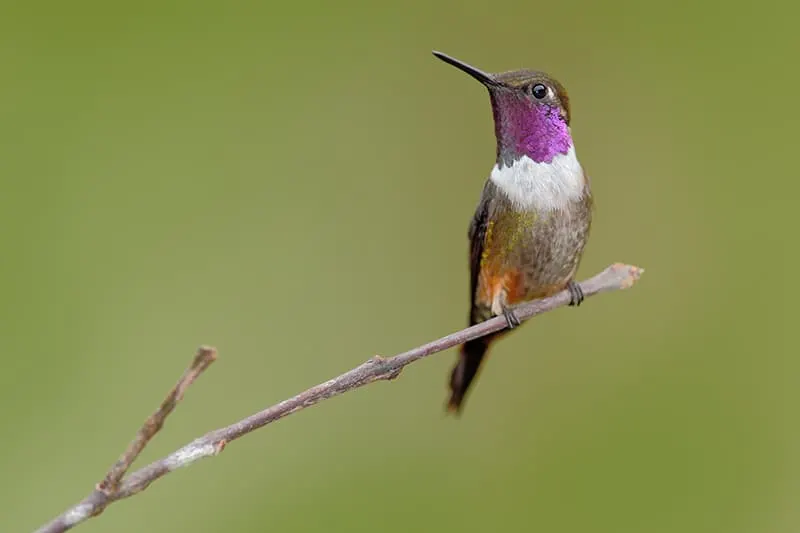
History
The hummingbird is named after the sound its wings make when it flies. Scientists believe hummingbirds split from swifts and treeswifts 30 million years ago. These hummingbird ancestors first lived in Asia and Europe. Hummingbirds showed up in the Americas 22 million years ago. Then they appeared in the Caribbean 5 million years ago. Scientists believe that new hummingbird species will continue to appear in the future.
Predators
Due to its small size, a hummingbird attracts a lot of predators. Predators of hummingbirds include cats, praying mantis, lizards, snakes, frogs, and fish. Hummingbirds are also tasty snacks for large birds like owls and hawks.
The biggest danger to hummingbirds is habitat loss. There are fewer hummingbirds when they have fewer places to live. They have fewer places to live in because people are moving into their areas. The IUCN Red List has several species of hummingbirds listed as endangered.
Lifespan
Many hummingbirds die before they are a year old because of predators and other factors. Once hummingbirds reach a year old, they have a good life expectancy. Hummingbirds usually live for an average of about 5 years.
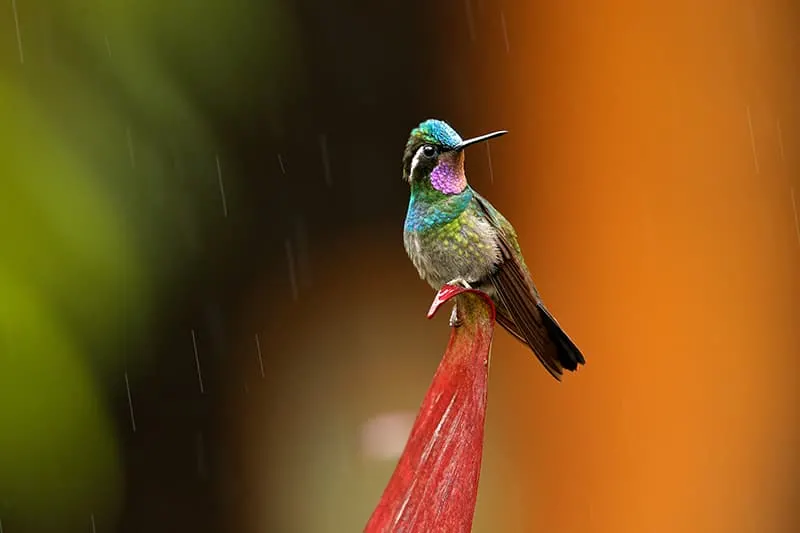
What Sound Does a Hummingbird Make?
Click on this audio file to hear what a hummingbird sounds like.
25+ Unusual Hummingbird Facts
- Hummingbirds are the smallest bird species in the world.
- The Bee hummingbird is the smallest hummingbird at 2 inches long.
- The Calliope hummingbird is the smallest bird in North America.
- The Giant Hummingbird is the largest hummingbird at 8 inches long.
- Giant Hummingbird eggs only weigh as much as a jumbo-sized paperclip.
- A Rufous hummingbird has the longest hummingbird migration route.
- Hummingbirds have large brains compared to their body size.
- Hummingbirds have the largest hearts compared to their body size.
- Hummingbirds have great vision but cannot smell.
- Hummingbirds breathe 7 times faster than humans.
- Hummingbirds are the only birds that can fly backwards.
- Hermit hummingbirds are unusual because the males sing in groups to attract females.
- Three newly hatched hummingbirds weigh less than a dime.
- Both mother and baby hummingbirds help keep the nest clean of waste.
- A hummingbird’s heart beats at least 2.5 times faster than a human’s heart.
- Hummingbirds can fly up to 30 miles an hour.
- A hummingbird’s courtship dive can be as fast as 60 miles per hour.
- Hummingbirds are attracted to the color red.
- People plant red flowers in their yard to attract hummingbirds.
- The Ruby-throated hummingbird is the most common hummingbird in North America.
- A hummingbird can’t walk or hop, but it can shuffle.
- Male hummingbirds’ feathers are brighter than those of females.
- Scientists believe hummingbirds migrate to the area where they hatched.
- Scientists don’t understand how a hummingbird chooses its migration path.
- The oldest hummingbird on record lived to be 12 years old.
- Some hummingbirds lay 3-5 broods in a nesting season.
- A hummingbird’s average heart rate is 250 times per minute
- A hummingbird’s wings beat 80 times per second.
We hope you enjoyed learning about hummingbirds! Did you learn anything new? Let us know any other facts you know about them. We can’t wait to hear from you!
You don't want to miss learning about these cool birds.
